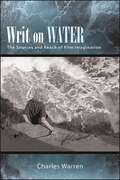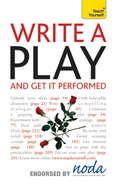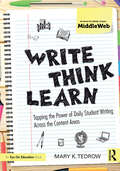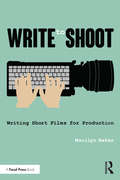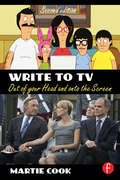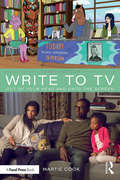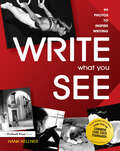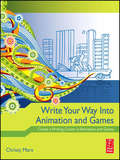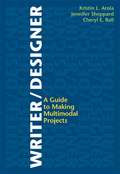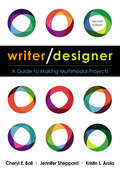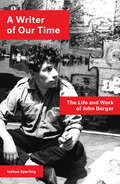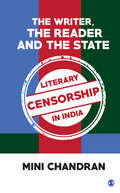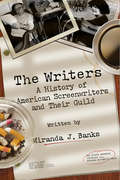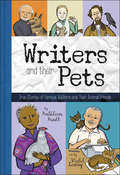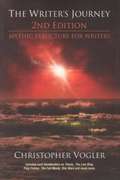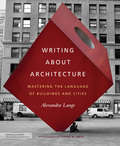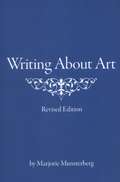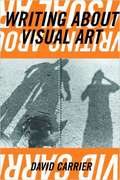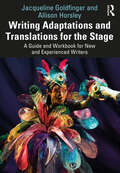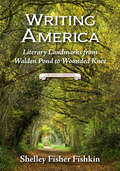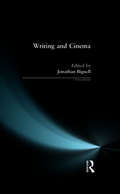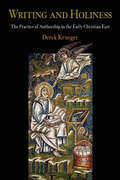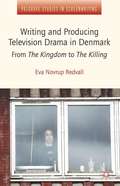- Table View
- List View
Writ on Water: The Sources and Reach of Film Imagination (SUNY series, Horizons of Cinema)
by Charles WarrenThis eloquent book draws on the author's responses to a wide range of extraordinary films—"long takes" on Altman's Nashville, Godard's Hail Mary, Makavejev's WR: Mysteries of the Organism, and von Sternberg's Blonde Venus, as well as "short takes" on films by Jean Rouch, Chris Marker, Chantal Akerman, Ross McElwee, Michelangelo Antonioni, Michael Haneke, and Jean-Pierre and Luc Dardenne. Charles Warren's masterful close readings blend profound philosophical reflections with a treasure trove of literary and artistic references to place film, in its relations to other arts, as one of the greatest aesthetic forms. Collectively, these essays offer an original and powerful statement on the nature of film and the intimate relation of what the author calls "film imagination" to our lives as human beings in the world. This important and much-needed book is no less than a celebration and affirmation of the very discipline of film criticism. One is left with one's appetite for film refreshed.
Write A Play - And Get It Performed: Teach Yourself
by Lesley Bown Ann GawthorpeWrite a Play - and Get It Performed is designed for would-be writers of every level and for all types of motivation by two prize-winning professionals. Whether writing for the specific needs of an amateur drama group, community event, political campaign or simply for personal or professional development, this is a guide to the craft of playwriting. It offers guidance on the creative principles of scripts, characters, plot, structure and dialogue and explains the principles of staging and stage directions as well as gives tips on how to write for a variety of different situations, for every age and ability and according to specific genres - particularly those often preferred by amateur groups, such as pantomime and musical theatre. NOT GOT MUCH TIME? One, five and ten-minute introductions to key principles to get you started. AUTHOR INSIGHTS Lots of instant help with common problems and quick tips for success, based on the author's many years of experience. TEST YOURSELF Tests in the book and online to keep track of your progress. EXTEND YOUR KNOWLEDGE Extra online articles at www.teachyourself.com to give you a richer understanding of writing a play. FIVE THINGS TO REMEMBER Quick refreshers to help you remember the key facts. TRY THIS Innovative exercises illustrate what you've learnt and how to use it.
Write A Play And Get It Performed: Teach Yourself
by Lesley Bown Lesley Hudswell Ann GawthorpeWrite a Play - and Get It Performed is designed for would-be writers of every level and for all types of motivation by two prize-winning professionals. Whether writing for the specific needs of an amateur drama group, community event, political campaign or simply for personal or professional development, this is a guide to the craft of playwriting. It offers guidance on the creative principles of scripts, characters, plot, structure and dialogue and explains the principles of staging and stage directions as well as gives tips on how to write for a variety of different situations, for every age and ability and according to specific genres - particularly those often preferred by amateur groups, such as pantomime and musical theatre.NOT GOT MUCH TIME?One, five and ten-minute introductions to key principles to get you started.AUTHOR INSIGHTSLots of instant help with common problems and quick tips for success, based on the author's many years of experience.TEST YOURSELFTests in the book and online to keep track of your progress.EXTEND YOUR KNOWLEDGEExtra online articles at www.teachyourself.com to give you a richer understanding of writing a play.FIVE THINGS TO REMEMBERQuick refreshers to help you remember the key facts.TRY THISInnovative exercises illustrate what you've learnt and how to use it.
Write, Think, Learn: Tapping the Power of Daily Student Writing Across the Content Areas
by Mary K. TedrowFind out how to create the climate and space for everyday student writing. In this new co-publication with MiddleWeb, award-winning teacher Mary Tedrow shows you how to encourage students to integrate daily writing into their lives, leading to improved critical thinking skills, increased knowledge of subject areas, and greater confidence in written expression. This practical guide will help you consider the unique needs of your students, while still meeting state standards. You’ll discover how to… Develop classroom routines and activities that invite creativity and self-expression Teach writing methods that can be used across different grade levels and all content areas Challenge students to examine their own writing processes for thinking and problem solving Evaluate written work in a way that emphasizes growth over grades Many exercises, prompts, and attempts at thinking found in the book can be easily adapted for use both in and out of the classroom. Whether you are a new or experienced teacher, Write, Think, Learn will enable you to make writing come alive for all your students.
Write to Shoot: Writing Short Films for Production
by Marilyn BekerWrite to Shoot teaches budding screenwriters and screenwriting filmmakers how to write a short script with production in mind. Beker instructs them how to showcase their strengths, tailor projects to shoestring budgets, resources, and practical production parameters without sacrificing the quality and punch of their screenplays, whether they're creating a sizzle short for an unproduced feature script, an independent creative work, or a soapbox to promote a cause. Write to Shoot: Writing Short Films for Production is a must-have guide for anyone who wants to be sure there will be no surprises on set that come from a script that's not ready for production.
Write to TV: Out of Your Head and onto the Screen
by Martie CookLearn to craft smart, original stories and scripts for a variety of television formats and genres, including comedy, drama, pilots, animation, made-for-TV movies, late night, and reality television. Hear directly from studio and network executives, agents, and managers on what they're looking for in new writers and how to avoid common pitfalls. Gain access to sample outlines, script pages, checklists, and countless other invaluable resources that will help you break into the industry and put you on the path to immediate success. In Write to TV, Second Edition industry veteran Martie Cook offers practical advice on writing innovative television scripts that will allow you to finally get that big idea out of your head and onto the screen. This new edition has been updated to include: Tips and techniques from industry vets Jay Leno, Norman Lear, Paul Haggis, David Magee, Susan Rovner, Tal Rabinowitz, Jonathan Littman, Peter Jankowski, Steve Stark, and Doug Herzog that you can immediately apply to your own projects Expanded coverage of writing pilots, pitching, writing webisodes, writing for tweens, writing for late night, and rewriting Useful advice for navigating the confusing television hierarchy, including how to network, get an agent, land that first writing job, and even "do lunch" 25 new interviews with writers and producers of hit shows such as New Girl, Parks and Recreation, The Blacklist, Curb Your Enthusiasm, CSI, The Tonight Show Starring Jimmy Fallon, and many more An all new companion website (www.writetotv.com) featuring blog updates, industry trends, a Q&A discussion forum with the author, and many other resources
Write to TV: Out of Your Head and onto the Screen
by Martie CookIn Write to TV (third edition) industry veteran Martie Cook offers practical advice on writing innovative television scripts that will allow you to finally get that big idea out of your head and onto the screen. With this book you’ll learn to craft smart, original stories and scripts for a variety of television formats and genres, including comedy, drama, pilots, web series, and subscription video on demand. This new edition has been updated with expanded coverage on writing for global audiences, content creation for streaming services such as Netflix, Amazon and Hulu, as well as writing the web series, podcasts and utilizing free platforms such as YouTube. It also features new chapters on writing for niche markets; breaking into the writers’ room; creating binge-worthy series and how to accompany pilot scripts with a series pitch document. Plus, expanded information on creating complex and compelling characters including writing anti-heroes and strong female protagonists and much, much more. Including information directly from studio and network executives, agents, and managers on what they’re looking for in new writers and how to avoid common pitfalls, advice from successful creators and showrunners on creating original content that sells, and tips from new writers on how to get into a writers room and stay there. This book contains information from more than 20 new interviews, access to sample outlines, script pages, checklists, and countless other invaluable resources, and is the ideal book for anyone who wants to break into the TV writing industry.
Write What You See: 99 Photos to Inspire Writing (Grades 7-12)
by Hank KellnerMotivate your students with the wide variety of photographs and writing prompts in this delightful book by award-winning photographer and former English teacher Hank Kellner.The varied prompts include key words, questions to consider, ideas for writing, possible opening lines, suggestions for research, and more. The book even comes with a CD so that you have the option of displaying the activities with an overhead projector.Write What You See contains a wealth of ideas for writing from the author as well as from real teachers across the country who have successfully used photography in the teaching of writing.Grades 7-12
Write Your Way into Animation and Games: Create a Writing Career in Animation and Games
by Christy MarxLaunch your career in writing for video games or animation with the best tips, tricks, and tutorials from the Focal press catalog--all at your fingertips. Let our award-winning writers and game developers show you how to generate ideas and create compelling storylines, concepts, and narratives for your next project. Write Your Way Into Animation and Games provides invaluable information on getting into the game and animation industries. You will benefit from decades of insider experience about the fields of animation and games, with an emphasis on what you really need to know to start working as a writer. Navigate the business aspects, gain unique skills, and develop the craft of writing specifically for aniamtion and games. Learn from the cream of the crop who have shared their knowledge and experience in these key Focal Press guides: Digital Storytelling, Second Edition by Carolyn Handler Miller Animation Writing and Development by Jean Ann Wright Writing for Animation, Comics, and Games by Christy Marx Story and Simulations for Serious Games by Nick Iuppa and Terry Borst Writing for Multimedia and the Web, Third Edition by Timothy Garrand
Writer Designer: A Guide to Making Multimodal Projects
by Kristin L. Arola Jennifer Sheppard Cheryl E. BallCreating multimodal projects can seem daunting, but Writer/Designer streamlines the multimodal composing process and makes it manageable for students. Designed to work in any college course, this brief, accessible book is here to help students whether they are creating a poster, a webtext, an animated video, or any other kind of text. Write/Design assignments guide students through the process of researching the right genre for their project, finding the tools to work with different media, drafting with mockups and storyboards, and presenting their final projects to the world.
Writer/Designer: A Guide to Making Multimodal Projects
by Cheryl E. Ball Jennifer Sheppard Kristin L. ArolaCreating multimodal projects can seem daunting, but Writer/Designer streamlines the multimodal composing process and makes it manageable for students. Designed to work in any college course, this brief, accessible book is here to help students whether they are creating a poster, a webtext, an animated video, or any other kind of text. Write/Design assignments guide students through the process of researching the right genre for their project, finding the tools to work with different media, drafting with mockups and storyboards, and presenting their final projects to the world. Online examples, tutorials, and activities in e-Pages take advantage of what the Web can do, showcasing real multimodal compositions from both students and professionals.
A Writer of Our Time: The Life and Work of John Berger
by Joshua SperlingThe first intellectual biography of the life and work of John BergerJohn Berger was one of the most influential thinkers and writers of postwar Europe. As a novelist, he won the Booker prize in 1972, donating half his prize money to the Black Panthers. As a TV presenter, he changed the way we looked at art with Ways of Seeing. As a storyteller and political activist, he defended the rights and dignity of workers, migrants, and the oppressed around the world. “Far from dragging politics into art,” he wrote in 1953, “art has dragged me into politics.” He remained a revolutionary up to his death in January 2017.Built around a series of watersheds, at once personal and historical, A Writer of Our Time traces Berger’s development from his roots as a postwar art student and polemicist in the Cold War battles of 1950s London, through the heady days of the 1960s—when the revolutions were not only political but sexual and artistic—to Berger’s reinvention as a rural storyteller and the long hangover that followed the rise and fall of the New Left.Drawing on first-hand, unpublished interviews and archival sources only recently made available, Joshua Sperling digs beneath the moments of controversy to reveal a figure of remarkable complexity and resilience. The portrait that emerges is of a cultural innovator as celebrated as he was often misunderstood, and a writer increasingly driven as much by what he loved as by what he opposed. A Writer of Our Time brings the many faces of John Berger together, repatriating one of our great minds to the intellectual dramas of his and our time.
The Writer, the Reader and the State: Literary Censorship in India
by Mini ChandranThis book offers a comprehensive account of the censorship of literature in India since Independence and the recent trends in literature banning The author recalls the literary censorship of books in India, both in English and in regional languages, and the impact of Emergency on banned books. The book highlights recent trends and current challenges to free literary expression in the country and attempts to locate it in the tradition of Indian literary history. The term ‘censorship’, used in the book, is a rubric that includes various repressive measures, both governmental and non-governmental, in banning a book after publication, withdrawing a book using coercive tactics or suppression of a work on other grounds. It adds a literary perspective to the process of reception of these books by the reader.
The Writers
by Miranda J. BanksScreenwriters are storytellers and dream builders. They forge new worlds and beings, bringing them to life through storylines and idiosyncratic details. Yet up until now, no one has told the story of these creative and indispensable artists. The Writers is the only comprehensive qualitative analysis of the history of writers and writing in the film, television, and streaming media industries in America. Featuring in-depth interviews with over fifty writers--including Mel Brooks, Norman Lear, Carl Reiner, and Frank Pierson--The Writers delivers a compelling, behind-the-scenes look at the role and rights of writers in Hollywood and New York over the past century. Granted unprecedented access to the archives of the Writers Guild Foundation, Miranda J. Banks also mines over 100 never-before-published oral histories with legends such as Nora Ephron and Ring Lardner Jr., whose insight and humor provide a window onto the enduring priorities, policies, and practices of the Writers Guild.With an ear for the language of storytellers, Banks deftly analyzes watershed moments in the industry: the advent of sound, World War II, the blacklist, ascension of television, the American New Wave, the rise and fall of VHS and DVD, and the boom of streaming media. The Writers spans historical and contemporary moments, and draws upon American cultural history, film and television scholarship and the passionate politics of labor and management. Published on the sixtieth anniversary of the formation of the Writers Guild of America, this book tells the story of the triumphs and struggles of these vociferous and contentious hero-makers.
Writers and Their Pets: True Stories of Famous Authors and Their Animal Friends
by Kathleen KrullDiscover how animals influenced 20 of the world’s most beloved authors, from Charles Dickens to J.K. Rowling. Did you know that a dog saved Pablo Neruda’s life? Or that Mark Twain had a cat named Bambino? Or that Edgar Allen Poe wrote with a cat on his shoulders? Writers and Their Pets tells these stories and many more with playful full-color illustrations that will delight not only children, but also literary experts, history lovers, and animal enthusiasts. Each short chapter focuses on one author’s life, using simple and entertaining text to weave tales of the pets that affected the lives and works of these writers, with illustrative artwork sprinkled throughout each page. This title features a diverse list of both male and female international authors, spanning from the 19th to the 21st century, including Beatrix Potter, E.B. White, Elizabeth Barrett Browning, Kurt Vonnegut, Maurice Sendak, Ernest Hemingway, and and more.
The Writer's Journey, Second Edition: Mythic Structure for Writers
by Christopher VoglerThe Writer's Journey sets forth archetypes common in what Vogler calls "the hero's journey," the mythic structure that he claims all stories follow. In the book's first section, he lists the different kinds of typological characters who appear in stories. In the second, he discusses the stages of the journey through which the hero generally passes. The final, supplementary portion of the book explains in detail how films like Titanic and The Full Monty follow the patterns he has outlined.
Writing About Architecture: Mastering the Language of Buildings and Cities
by Alexandra Lange Jeremy M. LangeExtraordinary architecture addresses so much more than mere practical considerations. It inspires and provokes while creating a seamless experience of the physical world for its users. It is the rare writer that can frame the discussion of a building in a way that allows the reader to see it with new eyes. Writing About Architecture is a handbook on writing effectively and critically about buildings and cities. Each chapter opens with a reprint of a significant essay written by a renowned architecture critic, followed by a close reading and discussion of the writer's strategies. Lange offers her own analysis using contemporary examples as well as a checklist of questions at the end of each chapter to help guide the writer. This important addition to the Architecture Briefs series is based on the author's design writing courses at New York University and the School of Visual Arts. Lange also writes a popular online column for Design Observer and has written for Dwell, Metropolis, New York magazine, and The New York Times. Writing About Architecture includes analysis of critical writings by Ada Louise Huxtable, Lewis Mumford, Herbert Muschamp, Michael Sorkin, Charles Moore, Frederick Law Olmsted, and Jane Jacobs. Architects covered include Marcel Breuer, Diller Scofidio + Renfro, Field Operations, Norman Foster, Frank Gehry, Frederick Law Olmsted, SOM, Louis Sullivan, and Frank Lloyd Wright.
Writing About Art (Revised Edition)
by Marjorie MunsterbergWriting About Art was written as the text for a course of the same name required of all art majors at The City College of New York. The book explains the different approaches college students encounter in undergraduate art history classes. Each chapter outlines the characteristics of one type of visual or historical analysis and briefly explains its history and development. Passages by well-known art historians provide examples of each method. Sample essays by students are accompanied by extensive explanations of suggested revisions. The book also includes a step-by-step guide to researching art historical topics and a section about correctly citing sources.
Writing about Visual Art
by David CarrierDavid Carrier examines the history and practice of art writing and reveals its importance to the art museum, the art gallery, and aesthetic theory. Artists, art historians, and art lovers alike can gain fresh insight into how written descriptions of painting and sculpture affect the experience of art. Readers will learn how their reading can determine the way they see painting and sculpture, how interpretations of art transform meaning and significance, and how much-discussed work becomes difficult to see afresh.
Writing Adaptations and Translations for the Stage: A Guide and Workbook for New and Experienced Writers
by Jacqueline Goldfinger Allison HorsleyWriting Adaptations and Translations for the Stage is a practical guide for writing adapted works for theatrical performance. Broadway translator and dramaturg Allison Horsley and award-winning playwright and educator Jacqueline Goldfinger take readers step-by-step through the brainstorming, writing, revision, and performance processes for translations and adaptations. The book includes lectures, case studies, writing exercises, and advice from top theater professionals on the process of creating, pitching, and producing adaptations and translations, covering a wide range of topics such as jukebox musicals, Shakespeare adaptations, plays from novels, theater for young adults, and theater in translation and using Indigenous language. Artists who share their wisdom in this book include: Des McAnuff (Tony Award), Emily Mann (Tony Award), Dominique Morisseau (Broadway Adaptor, Tony Award nominee, MacArthur Genius Fellow), Lisa Peterson (Obie Award, Lortel Award), Sarah Ruhl (Broadway Playwright, Tony Award nominee, Pulitzer Prize finalist, MacArthur Genius Fellow), and Tina Satter (Broadway Director, Obie Award, Guggenheim Fellowship). The book also features interviews with artists working both in the US and internationally, as well as guest columns from artists who work in less traditional adaptive forms including cabaret, burlesque, opera, community-engaged process, and commercial theater. Writing Adaptations and Translations for the Stage is an essential resource for students and instructors of Dramatic Writing, Playwriting, and Creative Writing courses and for aspiring playwrights.
Writing Adaptations and Translations for the Stage: A Guide and Workbook for New and Experienced Writers
by Jacqueline Goldfinger Allison HorsleyWriting Adaptations and Translations for the Stage is a practical guide for writing adapted works for theatrical performance.Broadway translator and dramaturg Allison Horsley and award-winning playwright and educator Jacqueline Goldfinger take readers step-by-step through the brainstorming, writing, revision, and performance processes for translations and adaptations. The book includes lectures, case studies, writing exercises, and advice from top theater professionals on the process of creating, pitching, and producing adaptations and translations, covering a wide range of topics such as jukebox musicals, Shakespeare adaptations, plays from novels, theater for young adults, and theater in translation and using Indigenous language. Artists who share their wisdom in this book include: Des McAnuff (Tony Award), Emily Mann (Tony Award), Dominique Morisseau (Broadway Adaptor, Tony Award nominee, MacArthur Genius Fellow), Lisa Peterson (Obie Award, Lortel Award), Sarah Ruhl (Broadway Playwright, Tony Award nominee, Pulitzer Prize finalist, MacArthur Genius Fellow), and Tina Satter (Broadway Director, Obie Award, Guggenheim Fellowship). The book also features interviews with artists working both in the US and internationally, as well as guest columns from artists who work in less traditional adaptive forms including cabaret, burlesque, opera, community-engaged process, and commercial theater.Writing Adaptations and Translations for the Stage is an essential resource for students and instructors of Dramatic Writing, Playwriting, and Creative Writing courses and for aspiring playwrights.
Writing America
by Shelley Fisher FishkinAmerican novelist E.L. Doctorow once observed that literature "endows places with meaning." Yet, as this wide-ranging new book vividly illustrates, understanding the places that shaped American writers' lives and their art can provide deep insight into what makes their literature truly meaningful. Published on the eve of the 50th anniversary of the Historic Preservation Act, Writing America is a unique, passionate, and eclectic series of meditations on literature and history, covering over 150 important National Register historic sites, all pivotal to the stories that make up America, from chapels to battlefields; from plantations to immigration stations; and from theaters to internment camps. The book considers not only the traditional sites for literary tourism, such as Mark Twain's sumptuous Connecticut home and the peaceful woods surrounding Walden Pond, but also locations that highlight the diversity of American literature, from the New York tenements that spawned Abraham Cahan's fiction to the Texas pump house that irrigated the fields in which the farm workers central to Gloria Anzaldúa's poetry picked produce. Rather than just providing a cursory overview of these authors' achievements, acclaimed literary scholar and cultural historian Shelley Fisher Fishkin offers a deep and personal reflection on how key sites bore witness to the struggles of American writers and inspired their dreams. She probes the global impact of American writers' innovative art and also examines the distinctive contributions to American culture by American writers who wrote in languages other than English, including Yiddish, Chinese, and Spanish. Only a scholar with as wide-ranging interests as Shelley Fisher Fishkin would dare to bring together in one book writers as diverse as Gloria Anzaldúa, Nicholas Black Elk, David Bradley, Abraham Cahan, S. Alice Callahan, Raymond Chandler, Frank Chin, Elizabeth Cook-Lynn, Countee Cullen, Frederick Douglass, Paul Laurence Dunbar, Jessie Fauset, William Faulkner, F. Scott Fitzgerald, Allen Ginsberg, Jovita González, Rolando Hinojosa, Langston Hughes, Zora Neale Hurston, Lawson Fusao Inada, James Weldon Johnson, Erica Jong, Maxine Hong Kingston, Irena Klepfisz, Nella Larsen, Emma Lazarus, Sinclair Lewis, Genny Lim, Claude McKay, Herman Melville, N. Scott Momaday, William Northup, John Okada, Miné Okubo, Simon Ortiz, Américo Paredes, John P. Parker, Ann Petry, Tomás Rivera, Wendy Rose, Morris Rosenfeld, John Steinbeck, Harriet Beecher Stowe, Henry David Thoreau, Mark Twain, Yoshiko Uchida, Tino Villanueva, Nathanael West, Walt Whitman, Richard Wright, Hisaye Yamamoto, Anzia Yezierska, and Zitkala-Ša. Leading readers on an enticing journey across the borders of physical places and imaginative terrains, the book includes over 60 images, and extended excerpts from a variety of literary works. Each chapter ends with resources for further exploration. Writing America reveals the alchemy though which American writers have transformed the world around them into art, changing their world and ours in the process. Table of ContentsList of Illustrations Acknowledgments Introduction: The Literary Landscape1 Celebrating the Many in One Walt Whitman Birthplace, Huntington, Long Island, New York2 Living in Harmony with Nature Walden Pond, Concord, Massachusetts3 Freedom's Port The New Bedford Whaling National Historical Park, New Bedford, Massachusetts4 The House that Uncle Tom's Cabin Built Harriet Beecher Stowe House, Hartford, Connecticut5 The Irony of American History The Mark Twain Boyhood Home, Hannibal, Missouri, and the Mark Twain House, Hartford, Connecticut6 Native American Voices Remember Wounded Knee, Pine Ridge Indian Reservation, South Dakota7 "I Know Why the Caged Bird Sings" The Paul Laurence Dunbar House, Dayton, Ohio8 Leaving the Old World for the New The Tenement Museum, New York City9 The Revolt from the Village The Original Main Street, Sauk Centre, Minnesota10 Asian American Writers and Creativ...
Writing and Cinema (Crosscurrents)
by Jonathan BignellThis collection of essays examines the ways in which writing and cinema can be studied in relation to each other. A wide range of material is presented, from essays which look at particular films, including The Piano and The English Patient, to discussions of the latest developments in film studies including psychoanalytic film theory and the cultural study of film audiences. Specific topics that the essays address also include: the kinds of writing produced for the cinema industry, advertising, film adaptations of written texts and theatre plays from nineteenth century 'classic' novels to recent cyberpunk science fiction such as Blade Runner and Starship Troopers. The essays deal with existing areas of debate, like questions of authorship and audience, and also break new ground, for example in proposing approaches to the study of writing on the cinema screen. The book includes a select bibliography, and a documents section gives details of a range of films for further study.
Writing and Holiness
by Derek KruegerDrawing on comparative literature, ritual and performance studies, and the history of asceticism, Derek Krueger explores how early Christian writers came to view writing as salvific, as worship through the production of art. Exploring the emergence of new and distinctly Christian ideas about authorship in late antiquity, Writing and Holiness probes saints' lives and hymns produced in the Greek East to reveal how the ascetic call to imitate Christ's humility rendered artistic and literary creativity problematic. In claiming authority and power, hagiographers appeared to violate the saintly practices that they sought to promote. Christian writers meditated within their texts on these tensions and ultimately developed a new set of answers to the question "What is an author?"Each of the texts examined here used writing as a technique for the representation of holiness. Some are narrative representations of saints that facilitate veneration; others are collections of accounts of miracles, composed to publicize a shrine. Rather than viewing an author's piety as a barrier to historical inquiry, Krueger argues that consideration of writing as a form of piety opens windows onto new modes of practice. He interprets Christian authors as participants in the religious system they described, as devotees, monastics, and faithful emulators of the saints, and he shows how their literary practice integrated authorship into other Christian practices, such as asceticism, devotion, pilgrimage, liturgy, and sacrifice. In considering the distinctly literary contributions to the formation of Christian piety in late antiquity, Writing and Holiness uncovers Christian literary theories with implications for both Eastern and Western medieval literatures.
Writing and Producing Television Drama in Denmark
by Eva Novrup RedvallOffering unique insights into the writing and production of television drama series such as The Killing and Borgen, produced by DR, the Danish Broadcasting Corporation, Novrup Redvall explores the creative collaborations in writers' rooms and 'production hotels' through detailed case studies of Denmark's public service production culture.
